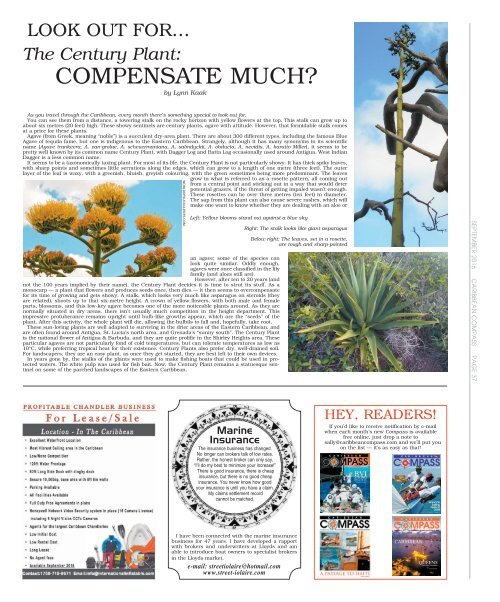Caribbean Compass Yachting Magazine September 2016
Welcome to Caribbean Compass, the most widely-read boating publication in the Caribbean! THE MOST NEWS YOU CAN USE - feature articles on cruising destinations, regattas, environment, events...
Welcome to Caribbean Compass, the most widely-read boating publication in the Caribbean! THE MOST NEWS YOU CAN USE - feature articles on cruising destinations, regattas, environment, events...
Create successful ePaper yourself
Turn your PDF publications into a flip-book with our unique Google optimized e-Paper software.
LOOK OUT FOR…<br />
The Century Plant:<br />
COMPENSATE MUCH?<br />
by Lynn Kaak<br />
As you travel through the <strong>Caribbean</strong>, every month there’s something special to look out for.<br />
You can see them from a distance, a towering stalk on the rocky horizon with yellow flowers at the top. This stalk can grow up to<br />
about six metres (20 feet) high. These showy sentinels are century plants, agave with attitude. However, that formidable stalk comes<br />
at a price for these plants.<br />
Agave (from Greek, meaning “noble”) is a succulent dry-area plant. There are about 300 different types, including the famous Blue<br />
Agave of tequila fame, but one is indigenous to the Eastern <strong>Caribbean</strong>. Strangely, although it has many synonyms in its scientific<br />
name (Agave trankeera, A. van-grolae, A. scheuermaniana, A. salmdyckii, A. obducta, A. nevidis, A. karatto Miller), it seems to be<br />
pretty well known by its common name Century Plant, with Dagger Log and Batta Log occasionally used around Antigua. West Indian<br />
Dagger is a less common name.<br />
It seems to be a taxonomically taxing plant. For most of its life, the Century Plant is not particularly showy. It has thick spiky leaves,<br />
with sharp points and sometimes little serrations along the edges, which can grow to a length of one metre (three feet). The outer<br />
layer of the leaf is waxy, with a greenish, bluish, greyish colouring, with the green sometimes being more predominant. The leaves<br />
grow in what is referred to as a rosette pattern, all coming out<br />
from a central point and sticking out in a way that would deter<br />
potential grazers, if the threat of getting impaled wasn’t enough.<br />
These rosettes can be over three metres (ten feet) in diameter.<br />
The sap from this plant can also cause severe rashes, which will<br />
make one want to know whether they are dealing with an aloe or<br />
an agave; some of the species can<br />
look quite similar. Oddly enough,<br />
agaves were once classified in the lily<br />
family (and aloes still are).<br />
However, after ten to 20 years (and<br />
not the 100 years implied by their name), the Century Plant decides it is time to strut its stuff. As a<br />
monocarp — a plant that flowers and produces seeds once, then dies — it then seems to overcompensate<br />
for its time of growing and gets showy. A stalk, which looks very much like asparagus on steroids (they<br />
are related), shoots up to that six-metre height. A crown of yellow flowers, with both male and female<br />
parts, blossoms, and this low-key agave becomes one of the more noticeable plants around. As they are<br />
normally situated in dry areas, there isn’t usually much competition in the height department. This<br />
impressive protuberance remains upright until bulb-like growths appear, which are the “seeds” of the<br />
plant. After this activity, the whole plant will die, allowing the bulbils to fall and, hopefully, take root.<br />
These sun-loving plants are well adapted to surviving in the drier areas of the Eastern <strong>Caribbean</strong>, and<br />
are often found around Antigua, St. Lucia’s north area, and Grenada’s “sunny south”. The Century Plant<br />
is the national flower of Antigua & Barbuda, and they are quite prolific in the Shirley Heights area. These<br />
particular agaves are not particularly fond of cold temperatures, but can tolerate temperatures as low as<br />
10°C, while preferring tropical heat for their existence. Century Plants also prefer dry, well-drained soil.<br />
For landscapers, they are an easy plant, as once they get started, they are best left to their own devices.<br />
In years gone by, the stalks of the plants were used to make fishing boats that could be used in protected<br />
waters. The white pulp was used for fish bait. Now, the Century Plant remains a statuesque sentinel<br />
on some of the parched landscapes of the Eastern <strong>Caribbean</strong>.<br />
WORLDOFSUCCULENTS.COM<br />
Left: Yellow blooms stand out against a blue sky<br />
Right: The stalk looks like giant asparagus<br />
Below right: The leaves, set in a rosette,<br />
are tough and sharp-pointed<br />
SEPTEMBER <strong>2016</strong> CARIBBEAN COMPASS PAGE 37<br />
Marine<br />
Insurance<br />
The insurance business has changed.<br />
No longer can brokers talk of low rates.<br />
Rather, the honest broker can only say,<br />
“I’ll do my best to minimize your increase!”<br />
There is good insurance, there is cheap<br />
insurance, but there is no good cheap<br />
insurance. You never know how good<br />
your insurance is until you have a claim.<br />
My claims settlement record<br />
cannot be matched.<br />
HEY, READERS!<br />
If you’d like to receive notification by e-mail<br />
when each month’s new <strong>Compass</strong> is available<br />
free online, just drop a note to<br />
sally@caribbeancompass.com and we’ll put you<br />
on the list — it’s as easy as that!<br />
I have been connected with the marine insurance<br />
business for 47 years. I have developed a rapport<br />
with brokers and underwriters at Lloyds and am<br />
able to introduce boat owners to specialist brokers<br />
in the Lloyds market.<br />
e-mail: streetiolaire@hotmail.com<br />
www.street-iolaire.com


















